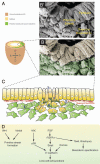Transitions between epithelial and mesenchymal states and the morphogenesis of the early mouse embryo
- PMID: 20200481
- PMCID: PMC2958623
- DOI: 10.4161/cam.4.3.10771
Transitions between epithelial and mesenchymal states and the morphogenesis of the early mouse embryo
Abstract
Multicellular organisms arise from the generation of different cell types and the organization of cells into tissues and organs. Cells of metazoa display two main phenotypes, the ancestral epithelial state and the recent mesenchymal derivative. Epithelial cells are usually stationary and reside in two-dimensional sheets. By contrast mesenchymal cells are loosely packed and can move to new positions, thereby providing a vehicle for cell rearrangement, dispersal and novel cell-cell interactions. Transitions between epithelial and mesenchymal states drive key morphogenetic events in the early vertebrate embryo, including gastrulation, germ layer formation and somitogenesis. The cell behaviors and molecular mechanisms promoting transitions between these two states in the early mouse embryo are discussed in this review.
Figures





References
-
- Bertet C, Sulak L, Lecuit T. Myosin-dependent junction remodelling controls planar cell intercalation and axis elongation. Nature. 2004;429:1–3. - PubMed
-
- Blankenship JT, Backovic ST, Sanny JS, Weitz O, Zallen JA. Multicellular rosette formation links planar cell polarity to tissue morphogenesis. Dev Cell. 2006;11:459–470. - PubMed
-
- Pilot F, Lecuit T. Compartmentalized morphogenesis in epithelia: from cell to tissue shape. Dev Dyn. 2005;232:685–694. - PubMed
-
- Cano A, Pérez-Moreno M, Rodrigo I, Locascio A, Blanco M, del Barrio M, et al. The transcription factor snail controls epithelial-mesenchymal transitions by repressing E-cadhrin expression. Nat Cell Biol. 2000;2:76–83. - PubMed
-
- Hay E. Organization and fine structure of epithelium and mesenchyme in the developing chick embryo. Baltimore: Williams and Wilkins; 1968.
Publication types
MeSH terms
Grants and funding
LinkOut - more resources
Full Text Sources
